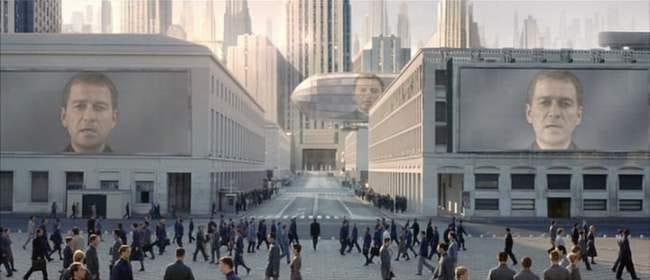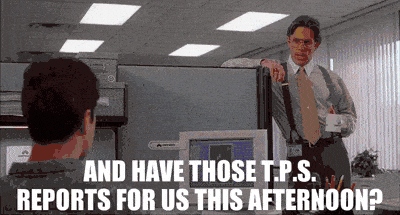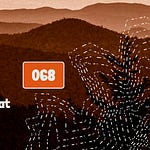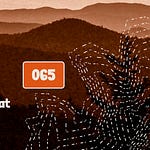Hello Everyone,
Yesterday I brought up the concepts of relational enmeshment and relational authenticity, which after a few conversations and dms, I realized I might need to spend a bit more time on. I’m sick, so I’ll do the best I can - feel free to comment if something need a bit more clarification.
Here’s my quick definitions:
Relational authenticity*: the understanding of one’s authentic self as not as isolated and separate from the world, developed internally, but rather perceiving and understanding ourselves as being formed in relation to the environment and entities around us. The world shapes us, and we in turn shape the world.
*I inherently see authenticity as relational.
Relational enmeshment: the sense of self that forms when we have no concept of self outside the environment and entities around us; a distinct lack of what Grace Aimoto explains as interiority, we try to fill by defining ourselves solely by labels and cultural norms.
I chose the film Equilibrium to represent these concepts yesterday for my graphics because of the difference between the characters of Partridge and Preston. It’s a favorite of mine, complete with the color palette, musical score, and and action you’d recognize from other franchises of the era such as The Matrix or Underworld. It explores themes of authenticity, connection, authoritarianism, individuality vs collective, resistance, and conscience.
Check it out this weekend if you need a suggestion of what to watch; I’ve included the scene I drew one of the gifs from yesterday to give a visual component to what follows, but warning, there is violent death.
Without spoiling the movie too much, through exposing himself to new experiences, art, etc. that is outside of his comfort zone and what is allowed by society, Partridge comes to understand himself better, his interiority not only expands, but he ultimately shows up in the world as his authentic self.
The experience in turn affects Preston, who initially urges Partridge to stay enmeshed in their external, labeled conceptions of self - they are Grammaton Clerics, law enforcement officers of the dystopian future city-state of Libria. What Partridge is doing, is not what they do.
Ultimately because of Partridge’s actions however, Preston comes to understand himself better, realizes the massive internal void he has been reinforcing over the years. He begins to seek realness, begins to question his role not just in his own enmeshment, but the forced enmeshment of others.
On a call recently with a junior leader (A) we were discussing the particulars of a situation they were facing regarding the actions of a peer (B) that was potentially trust breaking to their subordinates but trust-forming to their superiors because the issue lay at the intersection of policy and morale.
The plan of action of A to foster more trust with their subordinates was accompanied by a thought out logic so if a higher leader questioned them, they would be able to explain their actions and show forward thinking alignment with long term responsibilities.
After this plan had been undertaken it was derailed by B, who when confronted by A made it clear he was causing discomfort to their subordinates because it amused them.
Now, certain aspects of that situation aside, I pushed further since we had been talking about relational enmeshment (A had been struggling a bit), so I asked them to tell me whether they thought B was being their authentic self or displaying enmeshment, and why.
The conclusion was that B was very insecure, and had taken a position with this organization specifically to have the power to act in this manner with a wide degree of impunity. B technically was a model leader in following policy to the letter, but wasn’t done out of a sense of it being the right thing, but rather a self serving thing.
Insecurity can be a marker of inauthenticity, or at least indicate one doesn’t want to admit their weaknesses. But in this case - B felt they didn’t have to show weakness - because they were in charge. They enmeshed their sense of self to the organization, the role, the label, because they did not take the time to develop their own sense of self.
A, on the other hand, has done extensive self-examination and work. They joined the organization because it aligned with their views and lifestyle. When this situation arose, they questioned the policy because it conflicted with the long-term capabilities they needed to develop, which required absolute trust in A as a leader; they could do this because they had a sense of self that existed in relational alignment, not enmeshment, with the organization as a whole.
People can tell when their leaders are to be trusted, and when not. Typically, it comes down to how they are treated, but also consistency in that realm. Show up for your people as you, and not just a node of the organization, and it will be not only felt but reciprocated.
Who would you trust more, a leader who is authentic, or enmeshed?
Kizuna fall 2025 OpenEncounters:
If the concepts I’ve been discussing lately have your curiosity peaked, I invite you want to join us in the next leg of the journey through OpenArc, where over a four-week sequence of cross-disciplinary provocations, we will explore the question of:
“How do we co-create authenticity in the liminal space between self and collective across scales and contexts?”
While OpenThread broadened our perception of authenticity within ourselves and in relation to others, OpenArc considers what happens when these understandings meet the cultural narratives, communal dynamics, and more-than-human contexts that give them weight and form.
Community Tier pricing closes November 26, 11:59PM PT / 2:59AM ET
All Other Tier pricing closes November 28, 5PM ET / 2PM PT
Request Entry here
I’ll see you next Friday,
- Chris
Welcome, and thank you for your presence!
I am a leadership ecologist rooted in Appalachia, raised through environmental respect, military service and Western educational institutions. I use an animistic lens to better understand the relationship between individuals, organizations, and systems.
When working with leaders and organizations, my approach not one of doctrine, but of guidance and tending to: to memory, to culture, to systems and people. I believe leadership is not a fixed role, but a living, relational practice.
My work draws from my lived experience and research into myth-making, insurgency and business strategies, regenerative philosophies, creative works, the landscape I inhabit, and the mundane, because the ember of humanity is often nurtured in and between those spaces.
If something resonates, leave a comment, or reach out to chat - I always love hearing people’s stories.
You are always welcome to book a free call to either get fresh perspective or see if we’d work well together in cultivating your capacity to lead.
I offer a variety of services, 1:1 coaching, group programs, leadership training development, and culture consultation.














